“What would life be without this great passion?”
This is what my friend and former student Ria Mille asked in one of her emails. I first met Ria and her friend Rit Verhoeven when the two Belgian ladies attended my Maine Summer Quilt Retreat in 2012. I later featured the pair in a blog post of their own, “The Finish Line: The Belgian Connection.”
I’m proud to say I played my part in sparking Ria’s passion for fabric collage. That passion is evident in the quilts in this week’s edition of The Finish Line.
Ria caught on to the technique right away and has continued with it over the years, adding to what she calls her “zoo” of animal portraits. She has a beautiful grasp of the use of patterns in the fabric and a great eye for visual texture and light-dark value. She is also one of my students who uses naturalistic colors instead of the fanciful colors that I usually employ—and often encourage others to use.
Her most recent quilts are based on the photographs of famed National Geographic photographer Joel Sartore, whose “Photo Ark” series is “a groundbreaking effort to document species before they disappear—and to get people to care while there’s still time” (from the Photo Ark website).
Ria first contacted Sartore after reading my blog post about copyright entitled “Copyright and Copywrong: Finding an Image for Fabric Collage,” in which I raised the issue of using copyrighted images as inspiration for other art such as fabric collage quilts. She already her heart set on creating a quilt of two koalas based on a photo that she had found in a National Geographic Magazine article.
As she explained to me in her wonderful Belgian-tinged English:
Your blog about copyright sure was a wake-up call for me. I haven’t stop thinking about the koalas in National Geographic. So, I did the necessary research and found out the photographer is Joel Sartore. I explained about the classes and what I intended to do.
To my great relief his secretary replied the next day, giving me permission to use the photo mentioned. Coincidence or not: he is a great fan of quilts, and regularly visits the museum in Lincoln, Nebraska. The only thing he asked in return is to send an email with the result of my work. Which, no doubt, I will do next month. I also purchased his photo ark book, wherein he will write that I am welcome to use it as a source of inspiration.
Isn’t it just fantastic?
So, clear conscience, and a good lesson for the future.
I contacted Sartore before writing this post, asking if it was all right if I mentioned his generous permission, indicating that doing so might mean his fielding more requests for permission to use his photos from fabric collage quilters looking for suitable subjects. I received a courteous and enthusiastic reply from Sartore’s assistant. “If that means letting more folks know about the amazing species that need our help, by all means, please include the link to our website,” she wrote.
It should be noted that Sartore’s permission was granted solely for personal use. There is a licensing fee (which supports the Photo Ark project) of $125 or 10 percent of the sale price (whichever is greater) for use if the quilt is to be sold or entered into a competition for a prize.
All of the quilts below except for the gorilla are based on photos by Sartore. The gorilla quilt is based on a photograph by Robert Streithorst (used by permission). All quilts measure about 35 x 47 inches.
“Safe in Mom’s Arms”
When Ria emailed me pictures of her quilt of koalas, she said, “I gave the koala a last tweak (remembered the new word!) and took it to the quilt studio.” “Tweak” was an English word she learned at my Maine retreat and took home with her to Belgium.
Right off the bat, with this quilt, we can point out something that is a recurring theme in her work: a dark background. Again, she says she took her inspiration for this from Sartore, who often photographs these captive animals against a dark background. If it’s good enough for him, she said, why wouldn’t it work for her? Rather than black, she refers to the color as “chocolate.”
Ria says:
Most animals [in Sartore’s photos] have a chocolate brown background. I live in chocolate country after all. And didn’t great painters such as Vermeer use dark brown instead of black?
Big Horn Sheep
When I saw the work that Ria has been up to the last few years, it was quite evident that she’s been inspired to create her artwork on multiple levels. She has found that fabric collage is a technique she enjoys working with, and though having tried different approaches, says:
Sticking with the familiar technique works best for me. I think I found my own way of doing these collages; rather naturalistic.
Seeing one amazing animal quilt after another underscored the point that Ria was so very inspired with the photographic work of Sartore. I wonder if she realizes that by sharing her quilts—her passion—with me, and now with my readers, she helps to expand the reach of The Photo Ark.
The information about these animals comes from Joel Sartore’s books: “The Photo Ark,” “Birds of the Photo Ark,” and “Rare.” This world famous photographer is so open to sharing what he does because of his commitment to spreading the word about endangered species. Spreading awareness of their beauty and how worthwhile it is for us to do what we can to save them.
“Born to Be Wild”
The wolf is a red wolf originating from North Carolina, brought back from extinction. This specific one lives in a zoo in Sioux Falls, South Dakota. I named the quilt “Born to be Wild”. Although living in captivity, you can see the wild in his eyes.
Ria may see herself as working in “naturalistic” colors, but take a close look at this wolf, it’s a great example at how one can use alternative colors such as yellows for highlights, purples for shadows, and the rainbow of reds, greens, and blues for the values in-between. And in the end, it looks perfectly “natural.” I love it when that happens.
Ria asked that I make special mention of the quilter (from the Netherlands) who does her quilting. The back of “Born to Be Wild” shows how intricate the machine work is.
I just took my last 2 collages to Anne Lillholm, the lady who does the quilting. She is a prizewinning expert. I consider myself very lucky to let her do the last steps. She immediately understood what I needed. I never give any instructions as I cannot improve the expert. Isn’t that a bliss?
“Don’t Ruffle My Feathers”
I’m jealous of Ria’s condor. He reminds me of vultures, which are on my own list of future subjects. The heads of both species are both hideous and riveting.
Then comes the California condor. This bird is simply known as Male #50, and is living in captivity because a collision with Arizona’s Navajo Bridge dislocated his right wing.
Ria’s studio (above left) is in a bright and cute converted garden shed.
“My Sunday Dress”
Extreme closeups, such as Sartore’s macaw photo that Ria used as model for this quilt, are great choices for fabric collage. The photos are close enough to the subject to easily see fine details such as the eyes and the texture of the feathers.
It is such fun to work with bright colors again after all the brown and beige of the furry animals.
“Alpha Male”
Ria didn’t realize it at the time she made the quilt, but this gorilla is Harambe, the gorilla sadly made famous when he was shot and killed after a child fell into his enclosure at the Cincinnati Zoo. The photo was taken by Robert Steinhorst. His Facebook page includes several other photos of Harambe, as well as many other wild animals and other subjects.
At one point, Ria emailed me during the making of “Alpha Male,” bemoaning the lack of variety in her European fabric stores. We really are spoiled when it comes to the rich variety of fabrics we have access to here in the U.S.:
The attached beauty is my gorilla I am actually working on. Struggling for lack of fabric. We’ll have to wait for a quiltfair taking place in Holland. Although very often a bit disappointing, it offers a wider range of shops which—alas—mostly seem to offer the same batiks. I browsed through the webshop of Keepsake quilts, but find it very hard to buy without actually seeing the real thing.
Obviously Ria’s lack of fabrics doesn’t slow her down much, as she creates rich and haunting portraits of subjects that speak to her, and us.
Ria continues to create fabric collage quilts, though she says that even with Joel Sartore’s help, “finding a suitable subject remains the main challenge.”
Like all of us, she manages to find something about her work to criticize:
Although the collages turn out well, I sometimes feel I want to go back to my very first collage: the elephant [below]. It was less realistic, more adventurous with different colors. I suppose the reason why I dared to experiment was because I started from a black and white picture and was not influenced by the reality.
As a teacher I couldn’t have asked for a better student. Maybe someday I’ll get the chance to work with Ria again. Not that she needs to, but if loosening up her color choice is a goal, I’m sure I could help her with that.
My biggest dream is to have a class for advanced students, but I fear it remains a dream. The memory of beautiful Maine and the intense lessons remains vivid in my mind.
“What would life be without this great passion?” Ria asks.
The simple answer is less. We would all be impoverished without the work of people like Ria and like Joel Sartore and Robert Steinhorst.
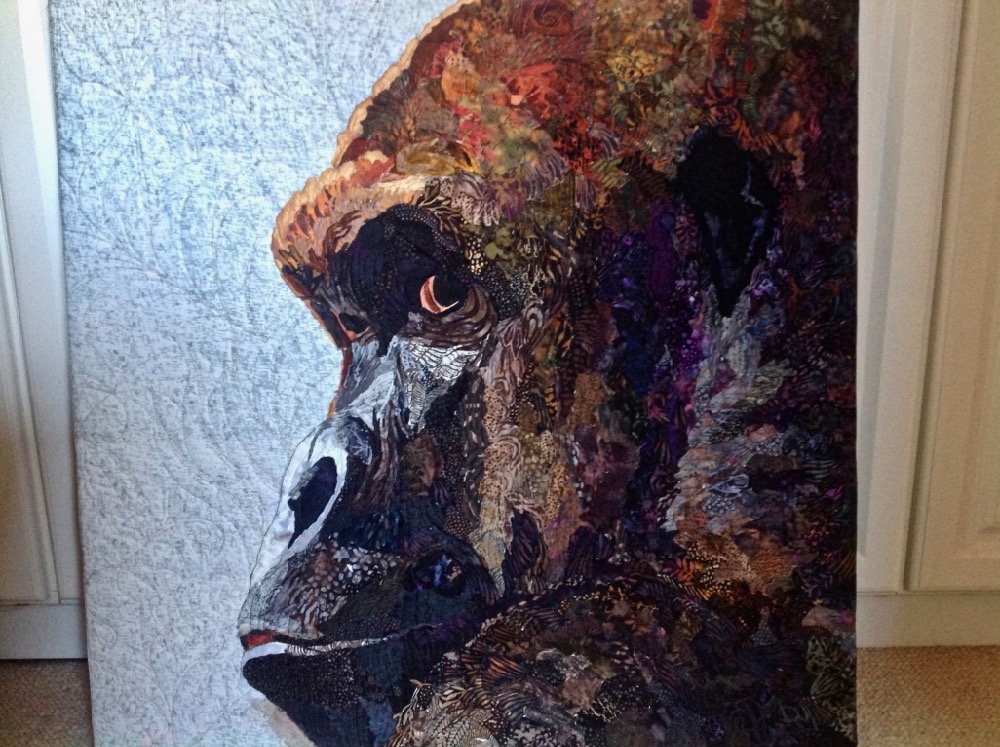
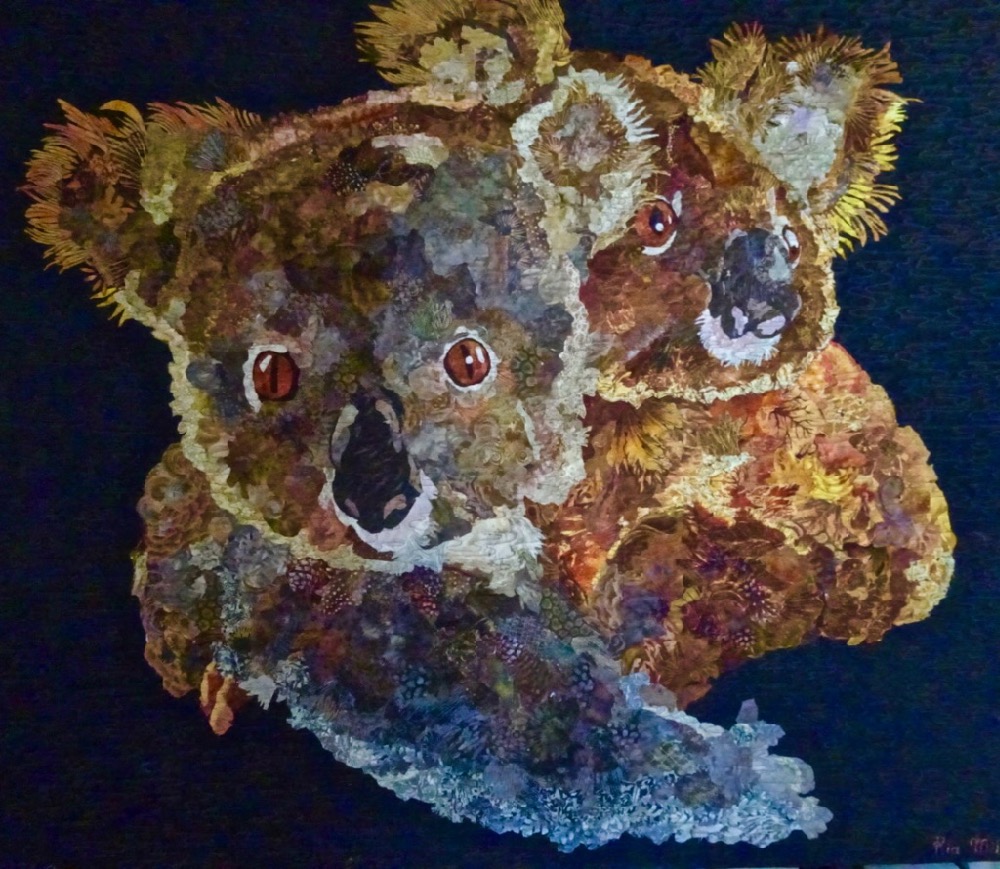


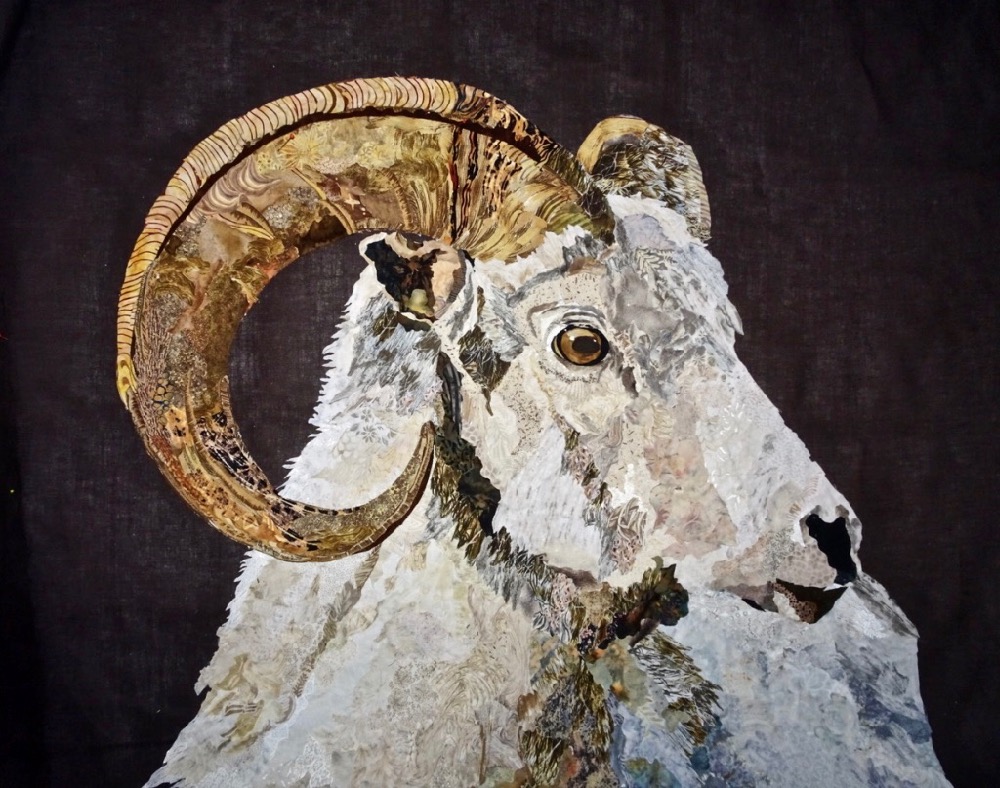
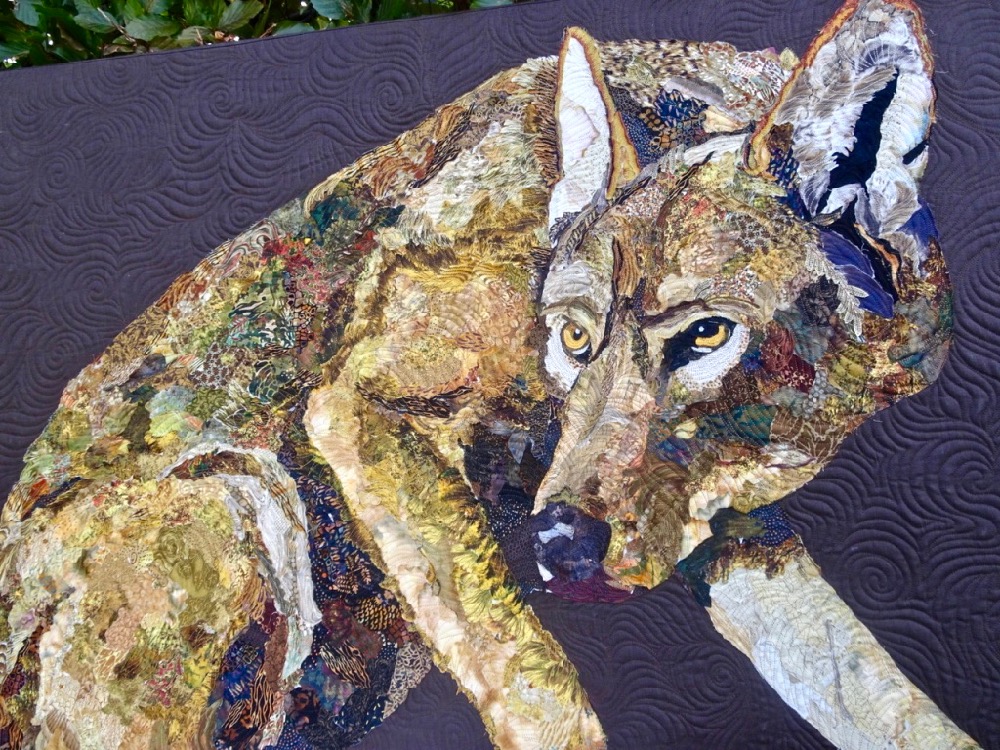
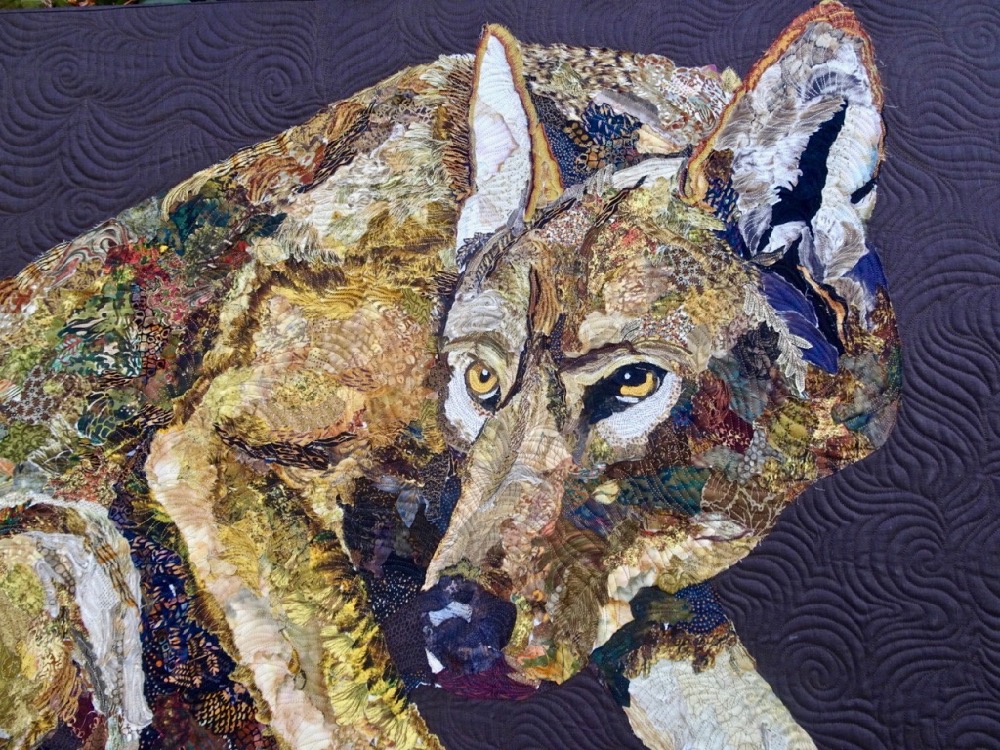


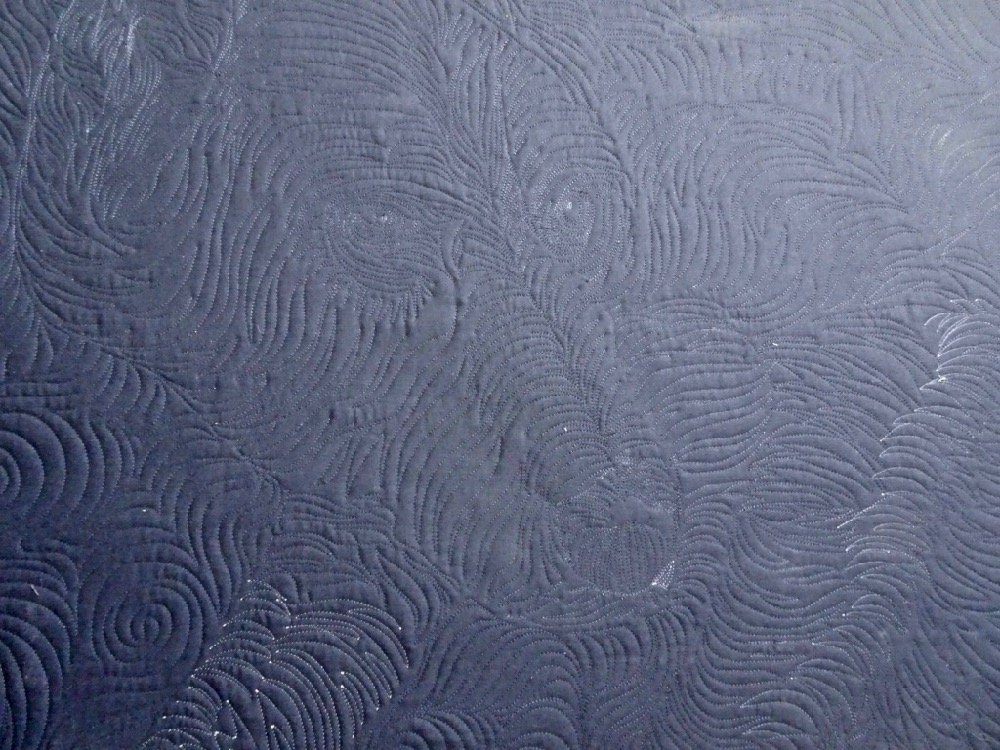
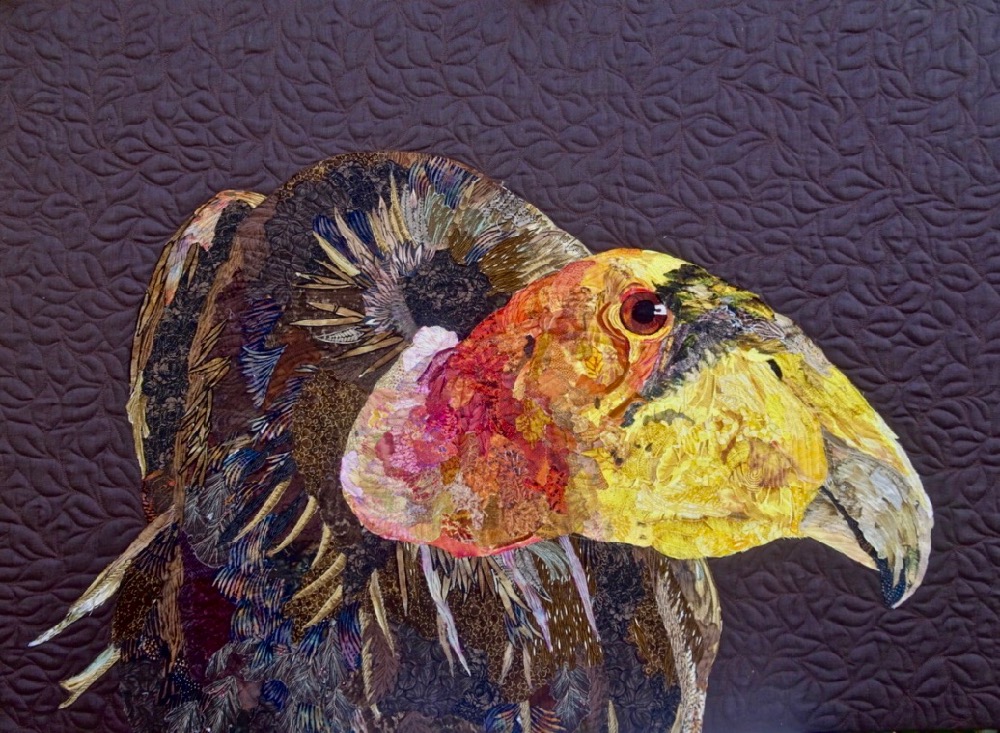
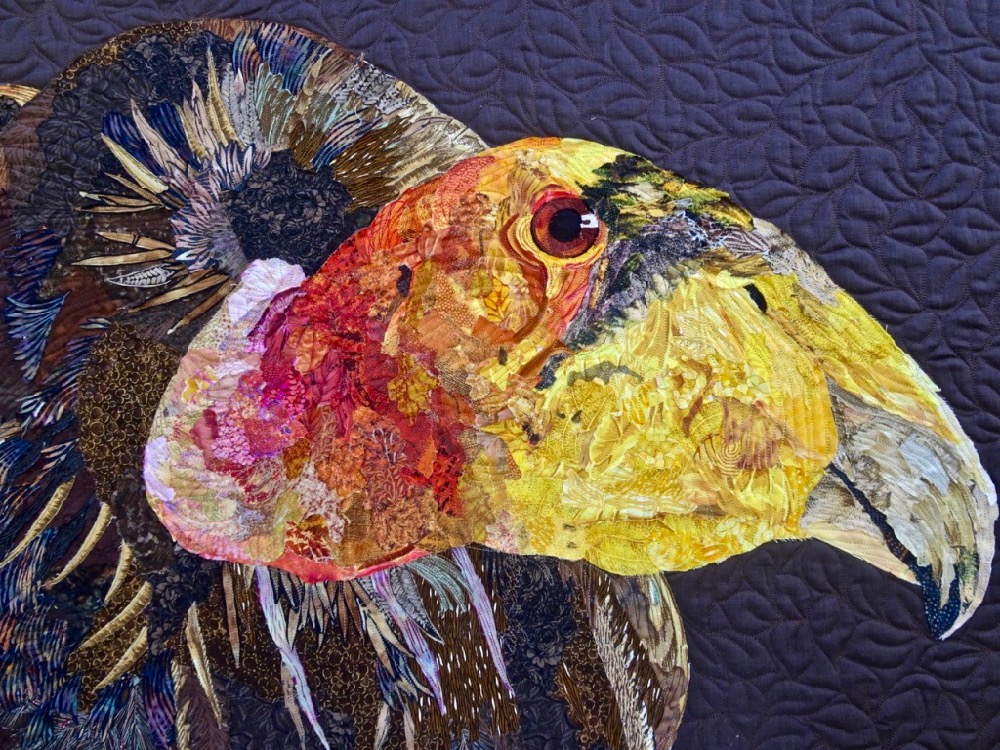


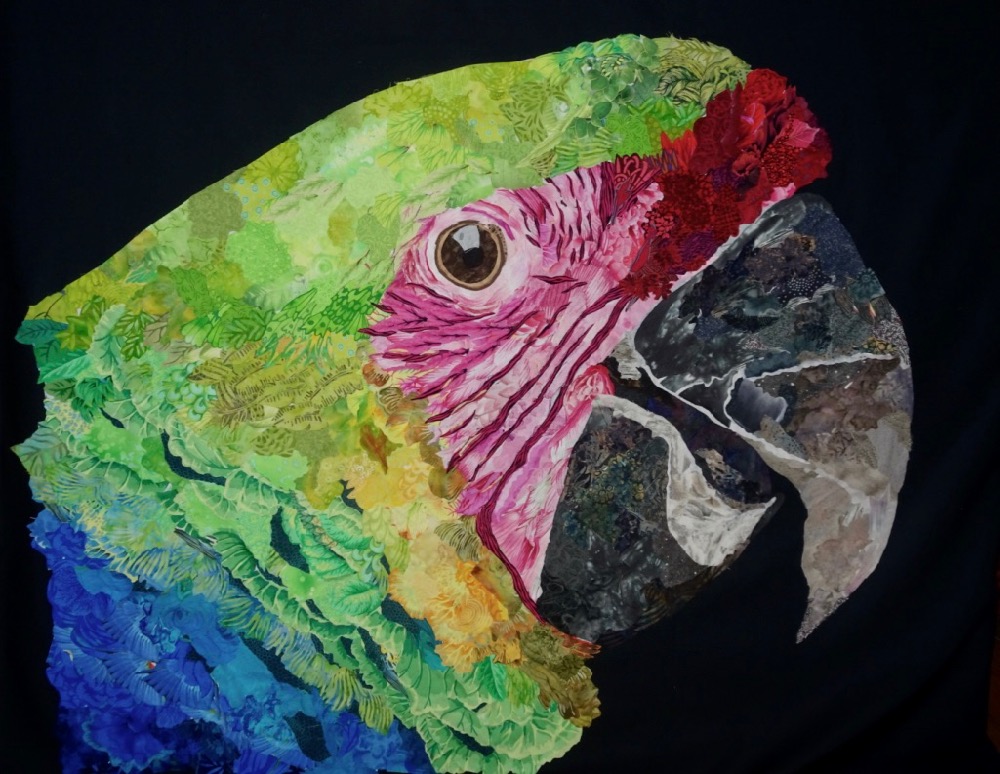



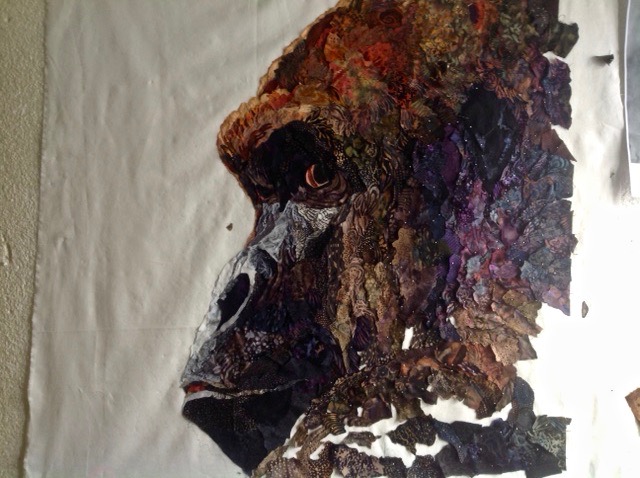
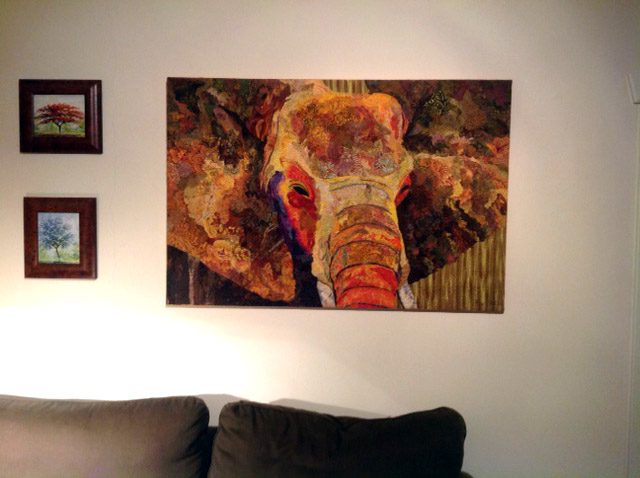
thank you for sharing these amazing, oil-painting-like works. thanks also for such a great explanation of getting permission to use someone else’s photography….
Amazing work!
It is always inspiring to see other textile collages and their stories. Ria’s was so informative and I truly hope she will journey back to Maine.
Wow! I love the elephant and the big horn sheep most, but they are all wonderful! Nice work, Ria!
Thanks for featuring Ria’s amazing animal pieces, and for telling us about The Photo Ark. I’m a huge National Geographic fan and have recently been sending my grandchildren and their kids the magazines, hoping to instill in them a greater love for animals.
Muchas gracias por compartir ese maravilloso trabajo. ¡ Felicidades!
Her quilts are special and inspirational ~ as are the individual creatures that his original photos depict. Thanks for sharing!
Hi All,
Ria is my wife’s friend and I admire both of their work, what Ria makes are not just quilts it is art, no more no less!
philip
Thank you so much for sharing these works of art! I have lived in Europe twice (my husband is retired Air Force and we lived in the Netherlands from 1974-1978 and Germany from 1986-1989). When you make friends with a European, it is my experience that you make friends for life. They are very family oriented (again, my experience) so don’t have as much time for friends as we seem to have here in the States. Every Sunday was family time when we lived there….I have been corresponding with a wonderful Dutch friend since we left the Netherlands in 1978. She is in her late 80s and her health is failing, but still she writes! Ria definitely has a gift for these collage quilts–so glad she met you!
These are just fabulous! Can you tell us how they are prepared for hanging?
Hello Nikki,
I first stitch a 9 cm wide strip to the quilt. Then have a custom made wooden frame on which the quilt is stretched. Staple on the backside, beginning from the opposite middles, then the other 2 sides and work towards the corners. That’s how Susan taught me.
success!
Oh Hello, I am new to this technique. I am also from Belgium. Love your quilts, they are truly art.
Susan,
I’d so love to take a class of yours, but it seems you never are near the Pacific Northwest.
I need to look for some of your books, I guess.
I love doing art quilts, have a little experience (with artists permission) duplicating works
of art, but nothing like you and your students.
Just loved seeing all this magnificent work by such talented women. Thanks for sharing.
Ria’s quilts are amazing. I too have a love of wildlife & am familiar with the Photo Ark book. Thanks to Joel Sartore for his permission to use his images. She might try Hancocks-Paducah.com for a wide range of batiks.
Thanks for the shopping advice. Problem is the high import tax. Have to figure it out before ordering. I checked their website and it looks very promising. Very tempting!